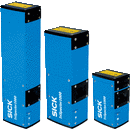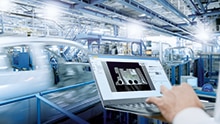When Jano Crema had an issue with rejects on his paper cup lid processing line, he needed a solution that would not only solve the issue, but add further value down the line. He found it. Here’s how.
3D camera technology solves headache for packaging company
Jano Crema had a problem. Over the past couple of years, some of his customers were being accidently short changed on their paper cup lids, a product that Crema’s company was producing. It wasn’t purposeful, but it was an issue that needed addressing, and addressing quickly. The company Crema specialises in making paper cups and lids for the food service industry, and it is a very competitive market. Having a customer call up and tell him that half their inventory they’ve paid for is missing is the last thing the business excellence manager wants to hear. However, due to the nature of the production line, it was a problem that couldn’t be solved by just putting more eyes on the conveyor belts in the hope numbers would right themselves.
Colliding problems in high speed line led to defects
“The line that makes the plastic lid for the cups is a very high-speed line,” said Crema. “We have a large number of machines that make cups. However, we only have one line that makes the lids. In terms of speed it is incredibly fast and is very highly automated meaning there is little opportunity to see a problem before it is packed. Every now and then we would get a complaint about only having half, or not the complete amount of lids in a sleeve going to the customer. It might happen only a couple of times a year, but it was annoying because it shouldn’t happen at all. We were looking for a way to automate the quality check of the high-speed production line so that we didn’t have to rely on the operators manually watching the line to avoid that issue.”
When Crema and his team went through and did their analysis of the issue, they identified that the sleeves were often being produced with issues or defects around the time there were other problems on the line. Often operators were busy trying to sort out other issues to get the line back up and running, which meant that the sleeves with the wrong amounts were being packed.
Enter the TriSpector1000 3D camera from SICK.
Reliable processes with easy to set up system
“We thought there must be some sort of technology out there that could help us,” said Crema. “I looked at the SICK website and took a look at the various options available. Given that I have an engineering and manufacturing background, I’m familiar with the processes and technology that are out there.
I came across the TriSpector1000. Given, the physical dimensions of what we were working with in terms of space within the line, and the dimensions of the product, I thought, ‘this is something that might be applicable’. I called up SICK, and spoke to [SICK sales engineer] Kevin Zarczynski, and we had a conversation about the issue. He said that it was something they could help us with. He invited me to come down to their site in Castle Hill in Sydney and we ran some trials on some products. We were able to validate that the system would be able to work.”
Zarczynski said that it was a relatively easy process that left both parties happy with the end result. “Jano gave us some samples, we did a preliminary test in our office, and he was able to see that preliminary test and that the proof of concept was a good solution,” said Zarczynski. “He bought the TriSpector1000, did the mounting and we did the programming. Due to COVID-19, it took a bit longer because it got caught in the fact nobody from SICK could go to site, but Jano and his team did a really good job of the mounting. Our service techs programmed it, and got it to pretty much work how they wanted in a prompt timeline.”
Crema and his team see the TriSpector1000 as a great solution for the issues they had. He also likes the fact that they can adjust it to suit their purpose. “When we first set up the system, we enabled a bypass because we needed to program each of our products as they went through,” said Crema. “We programmed the parameters for each of the products. Initially, we were finding that the operations were having to bypass because they were getting too many false alarms. Through that fine-tuning process of the parameters – the length, the height and the resolution of the TriSpector1000 – we were able to make that process a lot more reliable. We now have it to the point where the operators no longer need to have that bypass.
From our POV, the device is quite easy to set up, it is recalibrated, it has tools on board, so you don’t have to write anything to be able to do the measurements you want,” said Zarczynski. “You bolt it on, give it a speed and it makes pictures. In that way, it is a very easy-to-install product. One of its biggest assets for Jano’s company was that you could retrofit it to machinery. His machinery was not designed to have this type of camera on it, but it was easy to mount it above and take a picture of places you would never be able to take pictures before.”
Reducing customer complaints and increasing efficiency
One of the factors for installing the device was about reducing customer complaints. One of the key issues in the food and beverage industry is that Crema’s company is operating in a competitive market. One of the value adds for him is that his company needs to supply a quality product compared to their competitors. It was important to them that these avoidable defects were stopped. “We couldn’t just let them go,” he said. “For a relatively small investment, to put a system in place that automates this – and we have the confidence it works, and we don’t have to rely on a person being there on such a high-speed line – for us it was justified to avoid those complaints.”
Automated fault finding – measuring product length and height
And it’s not just its current use that piqued Crema’s interest in the TriSpector1000. He is looking at utilizing it further down the track to help the company become even more efficient. “It’s capable of multiple dimensions, which to me was the real selling point,” he said. “At the moment we are only using one dimension – to measure length. However, it is also capable of measuring height. By measuring a profile, it is a laser system that works over a distance that is able to generate a 3D surface profile of the products. That feature is hugely powerful and something – that now we understand the system – I’m looking for further applications where I can use that type of technology for automated fault finding. The challenge in any FMCG operation is that we are chasing outputs, higher speeds and more efficiency. If you’re doing a traditional, hand-picked sampling process, you are going to hit the limits of what you want to do effectively pretty quickly.”
Zarczynski agrees – measuring the length on a production line is just one of many features on the device. “It has a whole bunch of inspection tools that are preloaded to the camera for measuring volumes, distances and heights and being able to identify multiple things in the one task,” said Zarczynski. “In the one pass you can measure the height in every direction, but you can also get the volume and compare the volume from one side to the other. You can do these matches all in the one time.”
3D profiling helps to avoid product defects
Overall, Crema is more than happy with the TriSpector1000 and its ability to solve a problem that could have been ongoing and hurt the reputation of his company. He sees it as an ideal solution, even though there were others out there. “You can go down the process control path in order to try and ensure you don’t make defects,” he said. “However, I think that this type of technology, especially with 3D profiling capability, it has huge potential to allow much greater inspection of products in real time or during manufacture. You can be sure that almost every piece you make is perfect.”
Read more
3D localization with the Belt Pick SensorApp for pick-and-place tasks
Jam jars: vacuums a necessity
TriSpector: 3D image processing, intuitive operation








